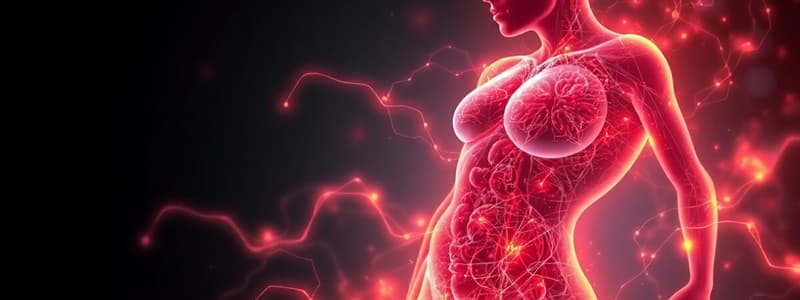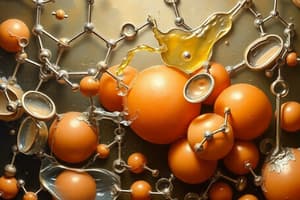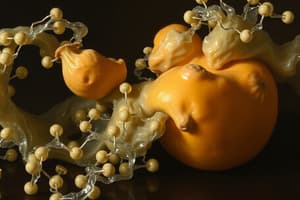Podcast
Questions and Answers
Which hormones stimulate lipolysis?
Which hormones stimulate lipolysis?
- Epinephrine and insulin
- Glucagon and epinephrine (correct)
- Insulin and norepinephrine
- Insulin and glucagon
β-oxidation occurs in the cytoplasm.
β-oxidation occurs in the cytoplasm.
False (B)
What is the rate-limiting step for the transport of fatty acids into the mitochondria during β-oxidation?
What is the rate-limiting step for the transport of fatty acids into the mitochondria during β-oxidation?
CPT I or carnitine palmitoyltransferase I
During lipolysis, triacylglycerols are broken down into glycerol and ______.
During lipolysis, triacylglycerols are broken down into glycerol and ______.
Match the enzymes with their respective roles in lipolysis:
Match the enzymes with their respective roles in lipolysis:
What is the primary product of the thiokinase reaction during β-oxidation?
What is the primary product of the thiokinase reaction during β-oxidation?
Insulin stimulates the breakdown of triacylglycerols.
Insulin stimulates the breakdown of triacylglycerols.
How many ATP are generated per molecule of acetyl-CoA that goes through the TCA cycle?
How many ATP are generated per molecule of acetyl-CoA that goes through the TCA cycle?
Flashcards
Lipolysis
Lipolysis
The breakdown of stored triglycerides into glycerol and free fatty acids, primarily occurring in adipose tissue.
Beta-oxidation
Beta-oxidation
The process where fatty acids are broken down into two-carbon units (acetyl-CoA) for energy production.
Glucagon
Glucagon
A hormone that stimulates lipolysis, mobilizing fatty acids for energy.
Insulin
Insulin
Signup and view all the flashcards
Adipose triglyceride lipase (ATGL)
Adipose triglyceride lipase (ATGL)
Signup and view all the flashcards
Hormone-sensitive lipase (HSL)
Hormone-sensitive lipase (HSL)
Signup and view all the flashcards
Carnitine Shuttle System
Carnitine Shuttle System
Signup and view all the flashcards
Beta-oxidation Cycle
Beta-oxidation Cycle
Signup and view all the flashcards
Study Notes
Triacylglycerol (TAG) and Fatty Acid Catabolism
- Purpose: Provides energy during fasting or increased energy demand. This involves lipolysis (TAG breakdown) and beta-oxidation (FA breakdown).
Lipolysis
- Definition: Breakdown of triacylglycerols into glycerol and free fatty acids (FFAs).
- Location: Adipose tissue.
- Hormonal Regulation: Stimulated by glucagon, epinephrine, and norepinephrine; inhibited by insulin. These hormones activate hormone-sensitive lipase (HSL) through cyclic AMP-dependent protein kinase (PKA).
- Enzymatic Steps:
- Adipose triglyceride lipase (ATGL): Converts triacylglycerol (TAG) to diacylglycerol (DAG).
- Hormone-sensitive lipase (HSL): Converts DAG to monoacylglycerol (MAG).
- Monoacylglycerol lipase (MAGL): Converts MAG to glycerol + a free fatty acid (FFA).
- Products:
- Glycerol: Transported to the liver for gluconeogenesis or glycolysis.
- Free Fatty Acids (FFAs): Bind to albumin in the blood and are transported to energy-demanding tissues.
Beta-Oxidation of Fatty Acids
- Definition: Stepwise removal of two-carbon units (as acetyl-CoA) from fatty acids for energy production.
- Location: Mitochondrial matrix. Long-chain fatty acids are first activated in the cytoplasm.
- Activation: Fatty acid + CoA + ATP → Acyl-CoA + AMP + PPi. Enzyme: Acyl-CoA synthetase (thiokinase).
- Transport into Mitochondria: The carnitine shuttle system moves acyl-CoA into the mitochondrial matrix:
- CPT I (carnitine palmitoyltransferase I): Converts acyl-CoA to acyl-carnitine (rate-limiting step).
- Acyl-carnitine is transported into the matrix by a translocase.
- CPT II regenerates acyl-CoA in the matrix.
- Beta-Oxidation Steps (spiral pathway):
- Oxidation: Acyl-CoA dehydrogenase forms a double bond; FAD → FADH₂.
- Hydration: Enoyl-CoA hydratase adds water.
- Oxidation: β-hydroxyacyl-CoA dehydrogenase forms NADH.
- Cleavage: Thiolase produces acetyl-CoA and a shortened acyl-CoA.
- Energy Yield per Cycle: 1 FADH₂ → 1.5 ATP; 1 NADH → 2.5 ATP. Each acetyl-CoA formed enters the citric acid cycle.
- Complete Oxidation Example (Palmitic Acid, C16): 7 cycles of beta-oxidation yield 7 FADH₂, 7 NADH, and 8 acetyl-CoA producing a total of 106 ATP (after accounting for activation energy).
- Regulation:
- Lipolysis: Stimulated by glucagon and epinephrine; inhibited by insulin.
- Beta-Oxidation: Inhibited by malonyl-CoA (which prevents CPT I activity during FA synthesis); stimulated by high FA availability and fasting state.
Studying That Suits You
Use AI to generate personalized quizzes and flashcards to suit your learning preferences.





